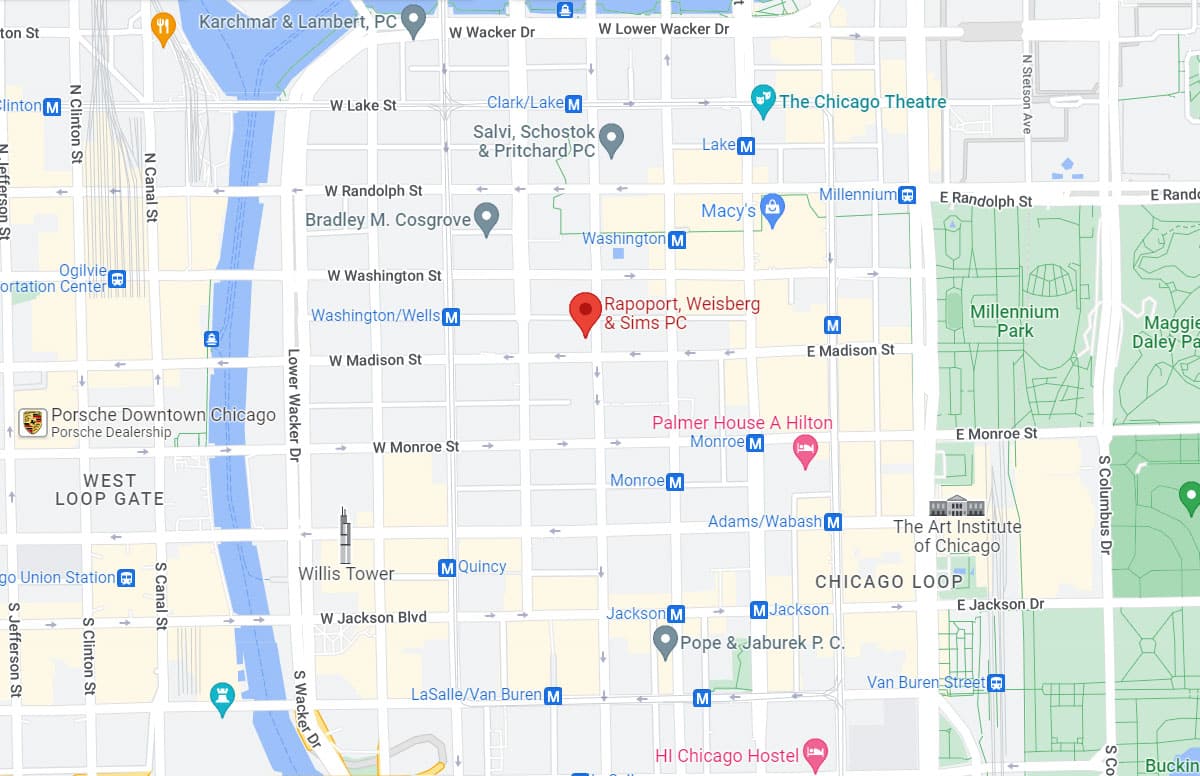As a parent, you want what’s best for your child. At birth, the only thing you’re worried about is if your child is healthy. Finding out that your child has a serious medical condition that could negatively affect their mobility and intellectual development is devastating. Knowing that outcome could have been prevented can be downright infuriating.
If your child was diagnosed with cerebral palsy and you believe a healthcare provider’s negligence is the cause, reach out to the Chicago cerebral palsy lawyers with Rapoport Weisberg Sims & VanOverloop P.C. It can be expensive to treat cerebral palsy, but a malpractice claim may be able to provide your family with the funds you need to manage this condition. Contact us today for a free case review.
What Is Cerebral Palsy?
The Centers for Disease Control and Prevention (CDC) characterizes cerebral palsy as a group of disorders that affect someone’s mobility, posture, and balance. Cerebral palsy is the most common mobility disorder people have during childhood. It is a permanent condition that cannot be cured, though there are ways to manage it through surgery and therapies.
Types of Cerebral Palsy
Cerebral palsy consists of multiple disorders. Doctors classify cerebral palsy according to the primary movement disorder your child suffers. Classification also depends on the brain area that is affected. Depending on these factors, cerebral palsy may include one or more of the following disorders:
Spastic Cerebral Palsy
Spastic cerebral palsy is characterized by stiffness. According to the CDC, this is the most common form of cerebral palsy, afflicting approximately 80% of people with the disorder. People with this condition may have one or more body parts affected. It is further classified according to the part(s) of the body affected.
This form of cerebral palsy is usually caused by a lesion in an upper motor neuron.
Dyskinesia Cerebral Palsy
Uncontrollable movements are what set this type of cerebral palsy apart from other types of cerebral palsy. People with this form of cerebral palsy may have difficulty controlling their limbs. They may have difficulty sitting or walking.
This cerebral palsy disorder often occurs after damage to the cerebellum, which controls coordination, involuntary movements, and reflexes.
Ataxic Cerebral Palsy
Poor balance and coordination correspond with ataxia cerebral palsy. Individuals with this condition may fall when they try to walk. They may have difficulty controlling fine motor movements. Damage to the cerebellum can cause this disorder.
Mixed Cerebral Palsy
Some people have multiple forms of cerebral palsy, such as spastic-dyskinetic cerebral palsy.
What Causes Cerebral Palsy?
According to the CDC, cerebral palsy is caused by abnormal development of the brain or damage to the brain. Sometimes, healthcare provider mistakes are responsible for this condition arising. The damage that leads to cerebral palsy can occur at one or more of the following stages:
In Utero
A baby’s brain may not develop correctly during pregnancy due to various problems, such as:
- The mother or child has an untreated infection
- Genetic disorders
- The mother’s immune system rejects the baby
- Insufficient oxygen delivery
Doctors are responsible for monitoring the mother and baby throughout the pregnancy and recognizing signs of fetal distress.
During Labor and Delivery
Many cases of cerebral palsy arise because of problems that occur during the labor and delivery process. The baby can suffer brain damage during this process because of mistakes such as:
- Not responding fast enough to signs of fetal distress
- Not realizing the baby’s umbilical cord has wrapped around their neck
- Administering too much medicine to induce labor
- Allowing a mother to continue with a prolonged labor rather than intervening
- Causing external trauma through the use of a vacuum or forceps
- Not diagnosing shoulder dystocia promptly to prevent oxygen deprivation during delivery
While you may think that doctors have the birthing process figured out and you can receive excellent care in the United States, keep this surprising statistic in mind: the rate of maternal death in the United States is more than ten times greater than the rates in some other high-income countries. Doctors can and do make mistakes that lead to tragic outcomes in the delivery rooms.
Trauma or Complications After Birth
Babies can experience trauma or complications after birth that could lead to cerebral palsy, such as:
- Jaundice
- Oxygen deprivation
- Exposure to toxic chemicals
- Infections
- Brain trauma
How Do I Know If My Child Has Cerebral Palsy?
Because there are so many different types of cerebral palsy and every child experiences the condition differently, it can sometimes be difficult to diagnose the condition. Some children with cerebral palsy may walk awkwardly and need some assistance in this area, but others may not be able to walk at all and may require lifelong treatment.
While cerebral palsy is considered a motor function disorder, many people with this condition have other concurrent medical conditions. For example, 40% of children with cerebral palsy also have epilepsy while 10% have autism. Cerebral palsy may be present along with other conditions, such as vision or hearing loss, spinal conditions, or intellectual disabilities.
The sooner you can have the condition diagnosed, the sooner you and your child can learn to manage it. Look for these signs if you suspect your child may have cerebral palsy:
Before Six Months
Some signs that your infant may have cerebral palsy include:
- Lagging head when you pick up your baby
- A feeling of stiffness or floppiness
- Crossing of legs when you pick up your baby
- Delays in reaching motor milestones, such as sitting or rolling over
Six Months to Ten Months
Babies who are in this age range may show symptoms of the disorder such as:
- Not rolling over in either direction
- Inability to bring hands together, such as clapping
- Reaching with only one hand
- Difficulty bringing their hands to their mouth
Older Than Ten Months
For babies older than ten months, you might start to notice that your child is missing other developmental milestones, such as standing or walking. Your child may also crawl with one hand and leg and drag the other portion of their body, or he or she may scoot on their bottom rather than crawl.
If you notice any of these signs above, inform your child’s pediatrician. These signs can be present in children without cerebral palsy. Your healthcare providers can perform screening and diagnostic tests.
What to Do When Medical Malpractice Causes Cerebral Palsy
If you suspect that your child suffered cerebral palsy because of a healthcare provider’s negligence, there are steps that you can take to protect your child and their legal rights. Start by contacting a Chicago cerebral palsy lawyer as soon as possible.
A medical malpractice lawyer can carefully review your child’s medical records and other evidence to help identify the party or parties who are responsible for the condition. Depending on the circumstances, this could include one or more of the following:
- Gynecologists and obstetricians
- Midwives
- Doulas
- Hospitals
- Doctors or nurses
- Anesthesiologists
Keep all of your medical records and provide them to your lawyer.
Cerebral Palsy FAQs
What Damages Can I Recover Through a Cerebral Palsy Claim?
Cerebral palsy is a permanent condition that can require lifelong care. Medical expenses can easily add up to hundreds of thousands of dollars. Through a cerebral palsy claim, you can seek compensation for medical expenses, such as:
- Surgery
- Hospital stays
- Adaptive medical devices
- Speech, physical, and occupational therapies
- Medications
- Travel to and from medical appointments
You may also miss significant time off work to take your child to various medical appointments. Your child may not be able to work independently because of their condition. You can seek compensation for these losses, too, through a cerebral palsy claim.
Why Should I File a Cerebral Palsy Claim?
In addition to pursuing the financial resources your family will likely need to pay for your child’s ongoing care, a cerebral palsy claim can help bring attention to the matter so that another family can hopefully avoid a similar situation. Nothing can rewind time to erase the mistake that caused your child’s cerebral palsy, but a legal claim can help you secure accountability.
What Do I Need to File a Cerebral Palsy Claim?
Cerebral palsy claims are often complex. You will want to give your lawyer all of your child’s medical records, including those during your pregnancy. You can also sign a release form in your lawyer’s favor so they can access this critical information, which may include:
- Doctor’s notes
- Surgical notes
- Photographs
- Imaging test results
- Diagnostic test results
- Birth records
- Medical bills
Illinois law also requires that you have an affidavit from a qualified healthcare provider who supports your claim of medical malpractice. An experienced Chicago cerebral palsy lawyer can work to ensure you have all of the necessary evidence to pursue your claim.
Contact a Chicago Cerebral Palsy Lawyer to Learn About Your Legal Options
If you suspect your child developed cerebral palsy as a result of a healthcare provider’s negligence, reach out to the Chicago cerebral palsy lawyers from Rapoport Weisberg Sims & VanOverloop P.C. We can answer any questions you have and explain how we can assist you during this difficult time. When you are ready to schedule a free, no-obligation consultation, contact us online or give us a call.

